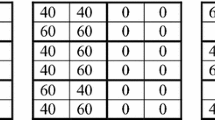Abstract
People studying rural communities typically limit their analyses to single communities or to comparatively large units, such as counties. This information is important, but it is in local subcounty areas where rural people live and work. We examine the appropriateness of minor civil divisions (MCD's) as a small ecological unit in nonmetropolitan areas to measure segregation between poor and nonpoor people. The index of dissimilarity (D) and P*-type contiguity indices are evaluated for the nonmetro portions of Mississippi and Wisconsin. MCD's are different in the two states, which affects the interpretation of the indices. We found that segregation, as measured by D, was low in both states. The low value of D in Mississippi may have resulted from how the state's MCD's were delineated. Although the P* indices are highly correlated with the poverty rate, they do provide more information than the poverty rate alone.
Similar content being viewed by others
Bibliography
Blum, J. M., B. Catton, E. S. Morgan, A. M. Schlesinger Jr., K. M. Stampp, C. V. Woodward: 1963, The National Experience (Harcourt, Brace & World, Inc, New York).
Bogue, D. J.: 1951, State Economic Areas (U.S. Census Bureau, Washington, D.C.).
Duncan, O. D., R. P. Cuzzort, and B. Duncan: 1961, Statistical Geography: Problems in Analyzing Area Data (The Free Press, Glencoe, Illinois).
Duncan, O. D. and D. Duncan: 1975, ‘Residential distribution and occupational stratification’, in Urban Social Segregation, ed. by C. Peach (Longman, London), pp. 51–66.
Erbe, B. M.: 1975, ‘Race and socioeconomic segregation’, American Sociological Review 40 (6), pp. 801–812.
Farley, R.: 1977, ‘Residential segregation in urbanized areas of the U.S. in 1970: Analysis of social class and racial differences’, Demography 14 (4), pp. 497–518.
Gelinne, T. G. and A. I. Winard: 1980, An Examination of the Poverty Area Definition in Metropolitan and Nonmetropolitan Areas. Paper presented at the annual meeting of the Population Association of America, Denver, Colorado.
Goldsmith, H. F., D. J. Jackson, S. Doenhoefer, W. Johnson, D. L. Tweed, D. Stiles, J. P. Barbano, and G. Warheit: 1984, The Health Demographic Profile System's Inventory of Small Area Social Indicators. Series BN, No. 4, (U.S. Department of Health and Human Services, National Institute of Mental Health, Washington, D.C.).
Hwang, S. and S. H. Murdock: 1983, ‘Segregation in nonmetropolitan and metropolitan Texas in 1980’, Rural Sociology 48(4), pp. 607–623.
Lieberson, S.: 1963, Ethnic Patterns in American Cities (The Free Press of Glencoe, New York).
Lieberson, S.: 1981, ‘An asymmetrical approach to segregation’, in Ethnic Segregation in Cities, ed. by C. Peach, V. Robinson, and S. Smith (The University of Georgia Press, Athens Georgia), pp. 61–82.
Marschner, B. J.: 1959, Land Use and Its Patterns in the United States. Agricultural Handbook No. 153 (U.S. Department of Agriculture, Agricultural Research Service, Farm Economics Research Division, Washington, D.C.).
National Research Council, Assembly of Behavioral and Social Sciences, Committee on National Statistics, Panel on Statistics for Rural Development Policy: 1981, ‘Summary and recommendations’, in Rural America in Passage: Statistics for Policy, ed. by D. M. Gilford, G. L. Nelson, and L. Ingram (National Academy Press, Washington, D.C.), pp. 189–207.
Peach, C.: 1975, ‘Introduction: The spatial analysis of ethnicity and class’, in Urban Social Segregation, ed. by C. Peach (Longman, London), pp. 1–20.
Rogers, D. L. and W. J. Goudy: 1981, ‘Community structure and occupational segregation 1960 and 1970’, Rural Sociology 46 (2), pp. 263–281.
Roof, W. C.: 1972, ‘Residential segregation of blacks and racial inequality in southern cities: Toward a causal model’, Social Problems 19 (3), pp. 393–407.
Sakoda, J. M.: 1981, ‘A generalized index of dissimilarity’, Demography 18 (2), pp. 245–250.
Stiles, D., H. F. Goldsmith, D. J. Jackson, J. Longest, and R. A. Hoppe: forthocoming, Percentile Distribution of Selected Social Indicators for 1980 Metropolitan Census Tracts.
Taeuber, K. E. and A. F. Taeuber: 1965, Negroes in Cities: Residential Segregation and Neighborhood Change, (Aldine Publishing Company, Chicago).
Tolbert, C.: 1986, forthcoming, Labor Market Areas in the United States. Technical Report (The Florida State University, Tallahassee, Florida).
U.S. Department of Commerce, Census Bureau: 1982a, 1980 Census of Population, Number of Inhabitants, Mississippi. PC80-1-A26 (U.S. Government Printing Office, Washington, D.C.).
U.S. Department of Commerce, Census Bureau: 1982b, 1980 Census of Population, Number of Inhabitants, Wisconsin. PC80-1-A51. (U.S. Government Printing Office, Washington, D.C.).
U.S. Department of Commerce, Census Bureau: 1982c, 1980 Census of Population and Housing, User's Guide, Part A, Text. PHC80-R1-A (U.S. Government Printing Office, Washington, D.C.).
U.S. Department of Commerce, Census Bureau: 1983a, 1980 Census of Population and Housing, Geographic Identification Code Scheme. PHC80-R5 (U.S. Government Printing Office, Washington, D.C.).
U.S. Department of Commerce, Census Bureau: 1983b, 1982 Census of Governments, Governmental Organization. GC82(1) (U.S. Government Printing Office, Washington, D.C.).
U.S. Department of Commerce, Census Bureau: 1985, Characteristics of the Population Below the Poverty Level: 1983. Series P60, No. 147 (U.S. Government Printing Office, Washington, D.C.).
Webster's Third New International Dictionary of the English Language, Unabridged: 1966 (G. & C. Merriam Co, Springfield, Massachusetts).
Zoloth, Barbara S.: 1976, ‘Alternative measures of school segregation’, Land Economics 52 (3), pp. 278–293.
Author information
Authors and Affiliations
Rights and permissions
About this article
Cite this article
Hoppe, R.A., Goldsmith, H., Stiles, D. et al. The value of symmetric and asymmetric indices of segregation constructed from MCD data. Soc Indic Res 19, 475–491 (1987). https://doi.org/10.1007/BF00300732
Received:
Issue Date:
DOI: https://doi.org/10.1007/BF00300732




